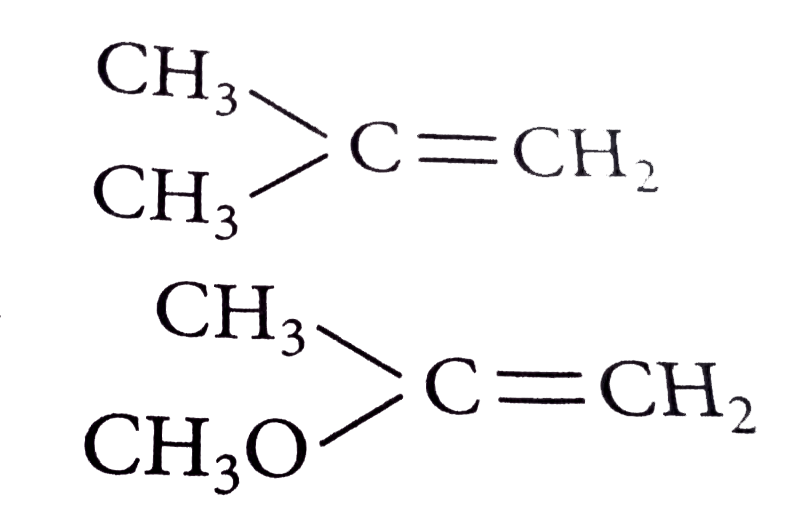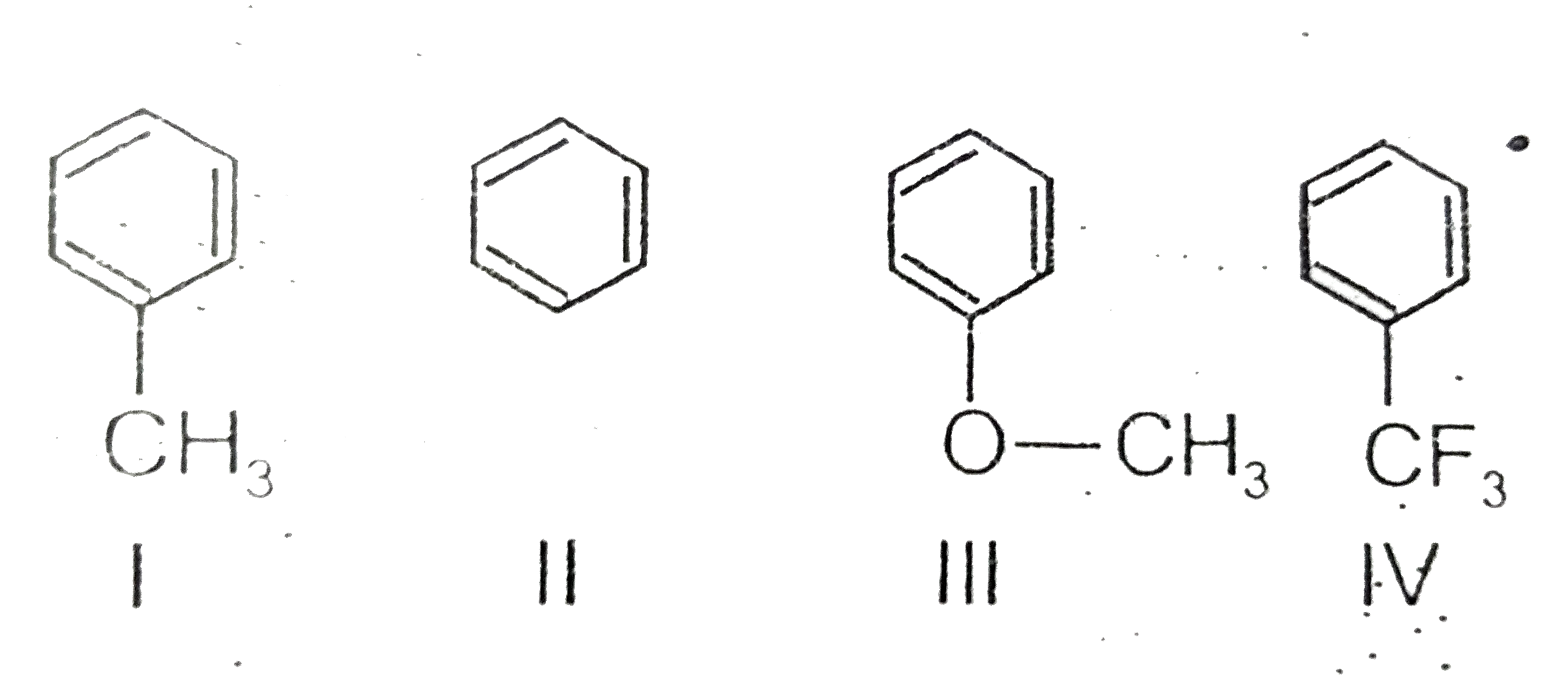Arrange the following in decreasing order of reactivity towards electrophilic substitution reaction
Aniline (I) , Acetanilide (II)
phenol (III) , Anilinium chloride (IV)
The correct Answer is:B
To arrange the compounds Aniline (I), Acetanilide (II), Phenol (III), and Anilinium chloride (IV) in decreasing order of reactivity towards electrophilic substitution reactions, we need to analyze the effect of each substituent on the benzene ring.
Step 1: Analyze Aniline (I)
- Aniline has an amino group (-NH2) attached to the benzene ring. The nitrogen atom has a lone pair of electrons that can be donated to the ring, increasing the electron density. This makes the benzene ring more reactive towards electrophiles.
Hint: Look for groups that can donate electron density to the benzene ring.
Step 2: Analyze Acetanilide (II)
- Acetanilide contains an amide group (-NHCOCH3). The nitrogen can still donate some electron density, but the carbonyl group (C=O) is electron-withdrawing through resonance. This reduces the overall electron density on the benzene ring compared to aniline.
Hint: Consider how electron-withdrawing groups affect reactivity.
Step 3: Analyze Phenol (III)
- Phenol has a hydroxyl group (-OH). The oxygen atom can donate electron density to the benzene ring, increasing its reactivity towards electrophiles. However, the effect is not as strong as that of the amino group in aniline.
Hint: Compare the strength of electron donation between -OH and -NH2 groups.
Step 4: Analyze Anilinium Chloride (IV)
- Anilinium chloride is the protonated form of aniline, where the amino group has a positive charge. This positive charge pulls electron density away from the benzene ring, making it less reactive towards electrophilic substitution.
Hint: Remember that positive charges generally decrease electron density.
Step 5: Compare Reactivities
- Based on the analysis:
1. Aniline (I) has the highest reactivity due to strong electron donation from the -NH2 group.
2. Phenol (III) is next, as the -OH group also donates electrons but is less effective than -NH2.
3. Acetanilide (II) follows, as the electron-withdrawing carbonyl group reduces the electron density.
4. Anilinium chloride (IV) is the least reactive due to the positive charge on nitrogen withdrawing electron density.
Final Order
The decreasing order of reactivity towards electrophilic substitution is:
1. Aniline (I)
2. Phenol (III)
3. Acetanilide (II)
4. Anilinium chloride (IV)
Summary
The final arrangement in decreasing order of reactivity towards electrophilic substitution reaction is:
Aniline (I) > Phenol (III) > Acetanilide (II) > Anilinium chloride (IV)
- Aniline has an amino group (-NH2) attached to the benzene ring. The nitrogen atom has a lone pair of electrons that can be donated to the ring, increasing the electron density. This makes the benzene ring more reactive towards electrophiles.
- Acetanilide contains an amide group (-NHCOCH3). The nitrogen can still donate some electron density, but the carbonyl group (C=O) is electron-withdrawing through resonance. This reduces the overall electron density on the benzene ring compared to aniline.
- Phenol has a hydroxyl group (-OH). The oxygen atom can donate electron density to the benzene ring, increasing its reactivity towards electrophiles. However, the effect is not as strong as that of the amino group in aniline.
- Anilinium chloride is the protonated form of aniline, where the amino group has a positive charge. This positive charge pulls electron density away from the benzene ring, making it less reactive towards electrophilic substitution.
- Based on the analysis:
1. Aniline (I) has the highest reactivity due to strong electron donation from the -NH2 group.
2. Phenol (III) is next, as the -OH group also donates electrons but is less effective than -NH2.
3. Acetanilide (II) follows, as the electron-withdrawing carbonyl group reduces the electron density.
4. Anilinium chloride (IV) is the least reactive due to the positive charge on nitrogen withdrawing electron density.
The decreasing order of reactivity towards electrophilic substitution is:
1. Aniline (I)
2. Phenol (III)
3. Acetanilide (II)
4. Anilinium chloride (IV)
The final arrangement in decreasing order of reactivity towards electrophilic substitution reaction is:
Aniline (I) > Phenol (III) > Acetanilide (II) > Anilinium chloride (IV)
Topper's Solved these Questions
Similar Questions
Knowledge Check
The correct order of reactivity towards electrophilic substitution is
Abenzene > phenol > benzoic acid > chlorobenzeneBphenol > benzene > chlorobenzene > benzoic acidCchlorobenzene > benzoic acid > phenol > benzeneDbenzoic acid > chlorobenzene > benzenegtphenol.Arrange the following in decreasing order of reactivity towards EAS (electrophilic aromatic substitution)
 Aa gt b gt cBc gt b gt aCa gt c gt bDc gt a gt b
Aa gt b gt cBc gt b gt aCa gt c gt bDc gt a gt bArrange the following compounds in order of their reactivity toward
 Ai<ii<iiiBi<iii<iiCii<i<IiiDii<iiil<i
Ai<ii<iiiBi<iii<iiCii<i<IiiDii<iiil<i
Arrange the following in decreasing order of their reactivity with an electrophile.

View SolutionArrange following compounds in decreasing order of rate of electrophilic substitution.

View SolutionRank the following compounds in decreasing order of reactivity in electrophilic aromatic substitution reaction

View SolutionArrange the following alkenes


in decreasing order of their reactivity towards HBr.
View SolutionArrange the following compounds in order of increasing reactivity towards nucleophilic substitution:

View Solution

_CHE_E06_235_Q01.png)
